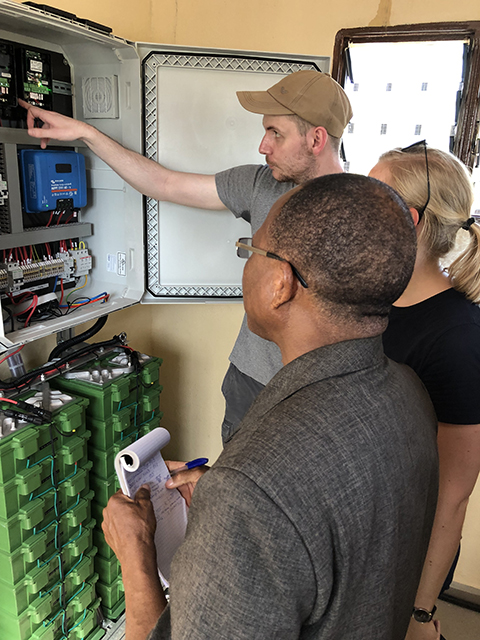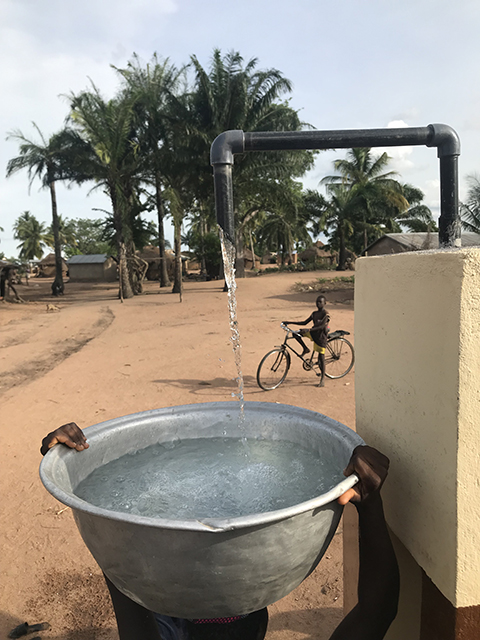End of May was absolutely last chance to go to Togo and install the Foundation’s battery pilot project. As the rainy season was slowly moving north towards the Plateaux Region from the coastal area in the south, we were lucky that the roads were still dry and we were able to get the equipment to the final destinations of Bouré and Iko-Akpa.
Documentation of installation
The Foundation’s new solar/battery pilot project was installed succesfully in both villages. In the video below you can get an impression of the installation process which lasted two days and involved a lot of people: Grundfos technicians Thomas and Nikolaj, Helene from PlanBørnefonden in Denmark, local Plan International staff, regional water authority staff and of course the contractors of ECM who had been building the infrastructure in collaboration with the community.
Battery pilot – installation May 2019 from Grundfos Foundation | PDJF on Vimeo.
You will hear several languages spoken in the video. Besides English and Danish, French and local dialects also appear.
In Togo, there are around 10,000 villages with less than 1,500 inhabitants and these villages are primarily served with handpumps today. The handpumps are installed and supervised by the local water authorities who also demand that each village elects a water committee (called AUSEPA) and makes sure that each household pays for the water. This also means that the local water authorities are an important player: they are actively involved in all of our water projects in the Plateaux region.

Grundfos Technician Nikolaj Vorre gives a guided tour of the control cabinet to a local water authority representative. The green boxes below are the saltwater batteries which are charged by solar panels. Photo: Thomas Christensen
Data will provide facts about consumption and performance
The new solar/battery systems will not only provide safe water to the villagers but more importantly make real-time data available via Grundfos Remote Management which will allow us to both monitor and evaluate the performance of the battery system in the tropical climate but also measure the environmental impact, especially with regards to the groundwater level. With the data, we would like to get bulletproof facts in order to propose new methods to provide better access to safe water in small last-mile communities.
- Togolese legislation prohibits the use of elevated water tanks in communities with less than 15,000 inhabitants. This makes quite good sense as there is significant risk of bacteria growth in such tanks in the tropical climate, so a community needs to have a certain consumption to avoid that the water stands still for weeks in the heat. This is why we are looking into energy storage rather than water storage in these two communities (800 and 250 inhabitants).
- Another rule says that a water system must deliver 30 litres per person per day. We have several systems with water tanks up and running in larger communities, and as far as we can see from the bookeping and reading the water metres, the actual consumption in these villages is maximum 10 litres per person per day in the dry season and a lot less in the rainy season. Because of this legislation, our test systems are heavily overdimensioned and therefore the test setup is not a financially interesting solution today. But it will provide us with important facts as we follow its performance and the users’ behaviour.
What we would ultimately like to show is
- that the solar panel/saltwater battery solution is indeed a sustainable and lasting alternative to water tanks
- that the system could be scaled to fit any size of community with simple building blocks, and that the only limitation is what the borehole can deliver
- tangible facts on the impact of groundwater pumping on the water table, as we have seen very few of those up until now (we also measure the groundwater level in our Kenyan water projects)

A ‘bassine’ contains about 30 litres of water. At the new tap stand in Bouré it fills up in about 4 minutes. Photo: Poul Due Jensen Foundation

